TABLE OF CONTENTS
NVIDIA’s slow trickle of SUPER GPUs continues with the RTX 4070 Ti SUPER. In addition to better performance, this particular release also bumps up the VRAM to 16GB and memory interface width to 256-bit compared to the RTX 4070 Ti (12GB and 192-bit) it will replace. But is it enough to warrant a $200 premium over the RTX 4070 SUPER?
Spoiler alert – not really, unless you need that additional VRAM.
Since NVIDIA isn’t making a Founders Edition for the RTX 4070 Ti SUPER, we’ll review an MSRP model instead (MSI RTX 4070 Ti SUPER VENTUS 3X). The 2.5-slot width was heartbreaking as soon as we unboxed this card, as this renders (pun intended) it useless for GPU rendering setups.
Addressing MSI RTX 4070 Ti SUPER VENTUS 3X Performance Concerns
Before diving into benchmarks and performance reviews, let’s talk about the performance concerns with MSI’s RTX 4070 Ti SUPER VENTUS 3X.
Several reviewers found a performance disparity between MSI’s VENTUS 3X model and others like ASUS’ TUF variant. MSI released two vBIOS updates to address the issue, and we used the latest available version for our tests – 95.03.45.40.F0.
We tested the card using the older BIOS and the newer one to check for any performance disparity, but our OctaneBench scores didn’t change much (within 1%). So, any issue specific to the MSI RTX 4070 Ti SUPER Ventus 3X (outside of updating the vBIOS, which we’ve already done) can’t be helped, as that is the only sample NVIDIA provided.
RTX 40 SUPER Lineup: Where Does the RTX 4070 Ti SUPER Fit?
NVIDIA announced its new RTX 40-Series lineup alongside its RTX 40 SUPER launch, which confirmed that the RTX 4070 Ti SUPER will replace the RTX 4070 Ti. Since the MSRP isn’t changing ($799), I expect a decent performance bump for this SUPER card compared to the outgoing model.
RTX 4070 Ti SUPER Specs and Pricing: Taking a Closer Look at the Full RTX 40-Series Lineup
Mid-cycle refreshes from NVIDIA usually include a core bump, and this release is no different. However, the difference looks pretty marginal compared to the RTX 4070 Ti.
| RTX 4070 | RTX 4070 SUPER | RTX 4070 Ti (Discontinued) | RTX 4070 Ti SUPER | RTX 4080 (Discontinued) | RTX 4080 SUPER | RTX 4090 | |
|---|---|---|---|---|---|---|---|
| VRAM | 12GB | 12GB | 12GB | 16GB | 16GB | 16GB | 24GB |
| GPU Die | AD104 | AD104 | AD104 | AD103 | AD103 | AD103 | AD102 |
| Shading Units (CUDA) | 5,888 | 7,168 | 7680 | 8,448 | 9728 | 10,240 | 16,384 |
| RT Cores | 46 | 56 | 60 | 66 | 76 | 80 | 128 |
| Tensor Cores | 184 | 224 | 240 | 264 | 304 | 320 | 512 |
| Base Clock/Boost Clock (MHz) | 1920 / 2475 | 1980 / 2475 | 2310 / 2610 | 2340 / 2610 | 2205 / 2505 | 2295 / 2550 | 2235 / 2520 |
| Memory Interface Width | 192-bit | 192-bit | 192-bit | 256-bit | 256-bit | 256-bit | 384-bit |
| MSRP (USD) | $549 | $599 | $799 | $799 | $1,199 | $999 | $1,599 |
Although we’re moving up to the AD103 die on the RTX 4070 Ti SUPER compared to AD104 on the RTX 4070 Ti, the increases in core counts aren’t too substantial. You’ll gain 10% more CUDA cores, 10% more RT cores, and 10% more Tensor cores.
If I had to guess before testing, I’d say the RTX 4070 Ti SUPER will offer around 7-12% more performance in creative tasks than the outgoing RTX 4070 Ti, along with more VRAM and a wider memory interface.
RTX 4070 Ti SUPER Performance Review and Benchmarks for Typical CG Workloads
Testing for creative workloads can get complicated due to the number of viable pipelines in the industry. In our testing, we’ll go over the most popular apps and GPU render engines to find out whether the RTX 4070 Ti SUPER is worth a buy over other options on shelves.
Support for AMD Radeon GPUs is picking up steam, but even from a price-to-performance standpoint, they generally don’t perform well enough to keep up with NVIDIA’s RTX offerings. Maybe the price cuts on the Radeon RX 7900XT graphics cards to $700-750 are attractive enough? Let’s find out!
GPU Rendering Benchmarks for MSI RTX 4070 Ti SUPER VENTUS 3X: Maxon Redshift, OctaneRender, V-Ray 6, and Blender
Thanks to its speed, GPU rendering has become one of the most effective ways of rendering a scene. What’s more, you can reduce render times linearly by adding more GPUs to your setup.
As most GPU render engines scale linearly with additional graphics cards, stacking more cards is always an attractive proposition for the future.
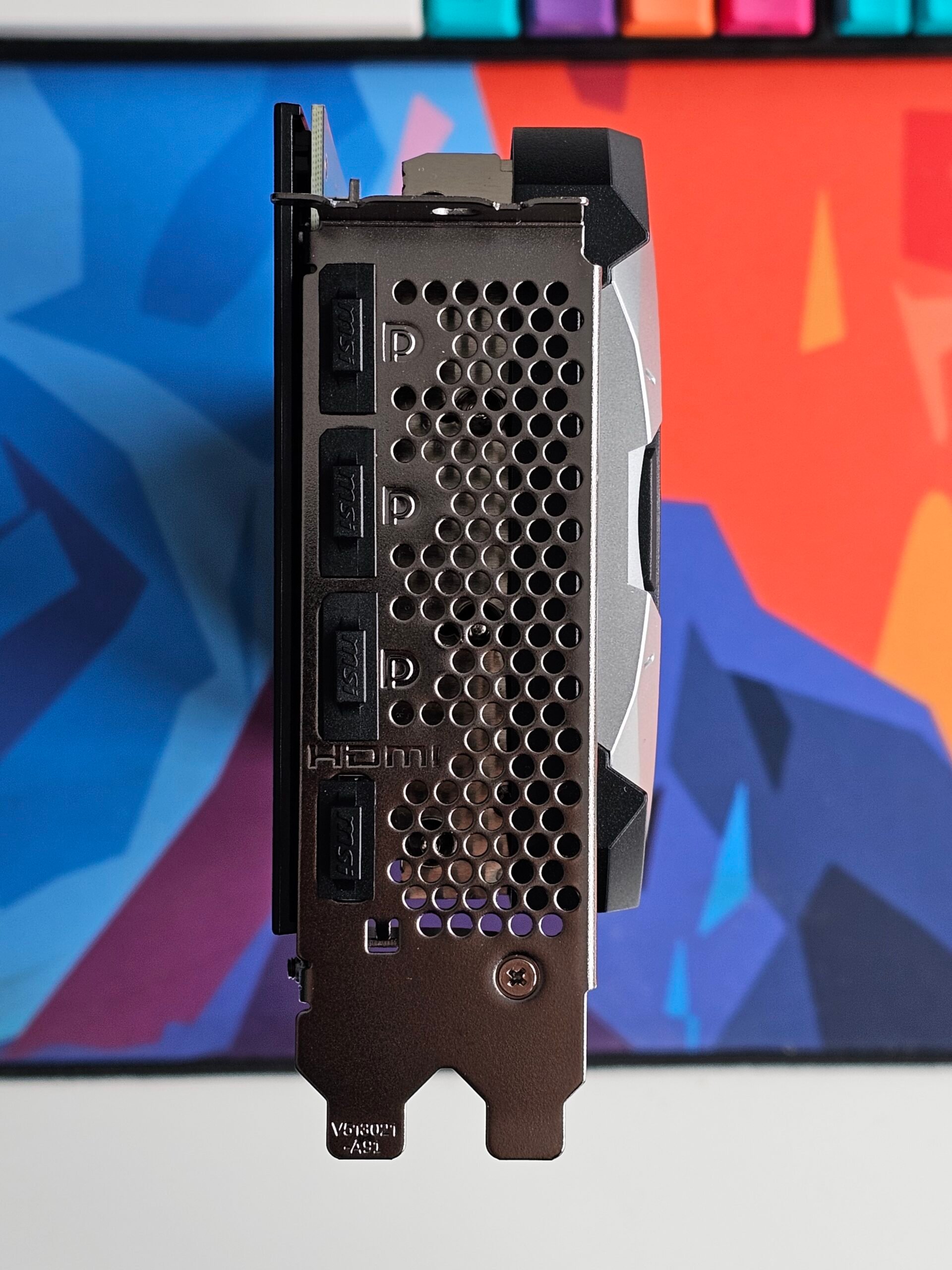
However, the MSI RTX 4070 Ti SUPER VENTUS 3X’s 2.5-slot makes it unsuitable for stacking configurations unless the performance is good enough to topple a quad-stacked RTX 4070 SUPER setup.
Maxon Redshift Benchmark 3.5.22
Maxon Redshift is the first GPU render engine we tested, and the results were somewhat disappointing. Compared to an RTX 4070 Ti, the RTX 4070 Ti SUPER only reduced render times by around 5%.
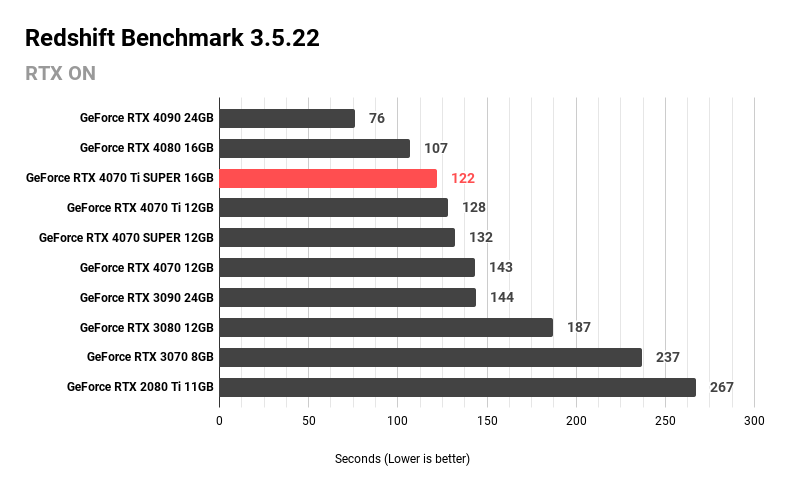
And it looks even worse when compared to the RTX 4070 SUPER, which is 7-8% slower, but is priced 25% lower than the RTX 4070 Ti SUPER.
Although AMD GPUs are an option for Redshift now, their performance still isn’t great because the engine uses only AMD HIP and doesn’t support HIP-RT (yet). Without HIP-RT, Redshift cannot use Radeon’s Ray Accelerators, which puts them at a significant disadvantage compared to Team Green.
We still can’t recommend using Radeon cards for Redshift workloads because any RTX 40-series card will obliterate them. Hopefully, the status quo changes this year.
Cinebench 2024.1.0
Maxon’s Cinebench 2024 GPU benchmark is also based on the Redshift render engine, but the performance disparity between the RTX 4070 Ti and the RTX 4070 Ti SUPER is slightly different.
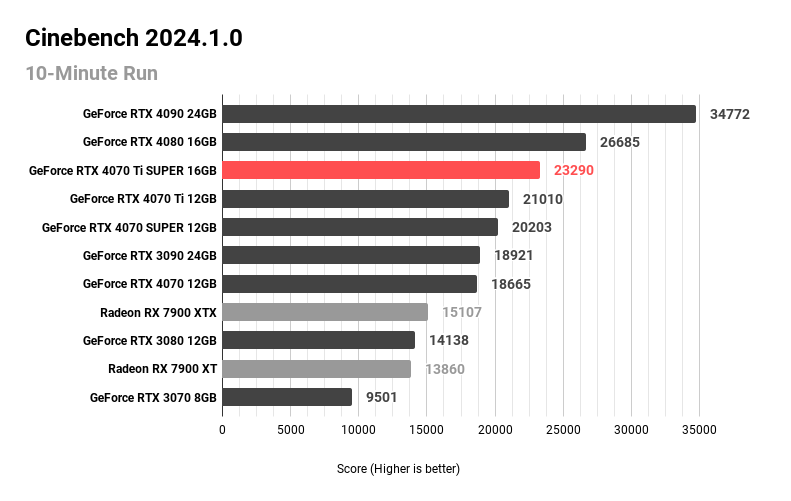
Here, we see the expected 10% performance uplift between the two cards. With the RTX 4070 SUPER sitting at 15% lower performance than the RTX 4070 Ti SUPER, it’s hard to recommend spending the additional $200 unless you need the VRAM bump for your work.
The RTX 4070 Ti SUPER’s 2.5-slot width makes it hard to recommend for a rendering setup because a stack of 4x RTX 4070 SUPER graphics cards will outperform nearly any other configuration in a regular Full Tower case.
As for the Radeons…well, you see why we don’t recommend them for Redshift workloads yet.
OTOY Octanebench 2020.1.5
OctaneRender is an unbiased GPU render engine that only supports NVIDIA graphics cards. Like Redshift, it also benefits from additional GPUs to reduce render times linearly.
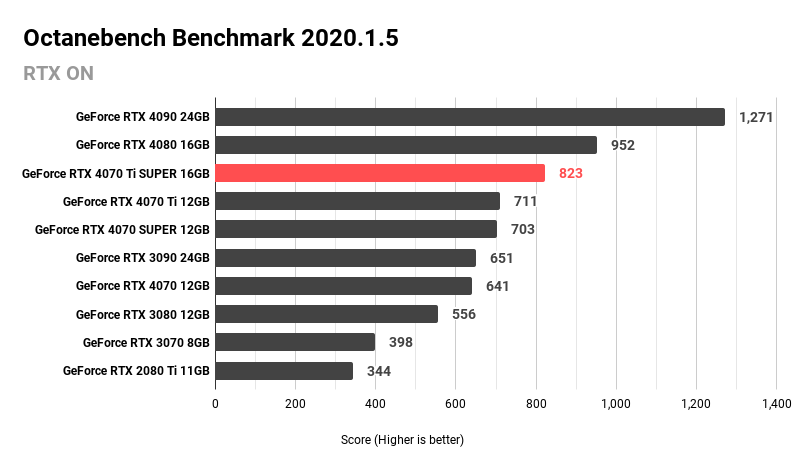
We see a decent 15% performance bump in Octane over the RTX 4070 Ti. However, the RTX 4070 SUPER also scores nearly the same as an RTX 4070 Ti – making the RTX 4070 Ti SUPER seem like worse value, even in NVIDIA’s own product lineup.
V-Ray 6 CUDA/RTX Benchmark
V-Ray is one of the oldest 3D rendering plugins around, with its first release dating all the way back to 1997. It remains a popular option partly because it supports all major professional design platforms like 3ds Max, SketchUp, Rhino, Revit, Maya, and more.
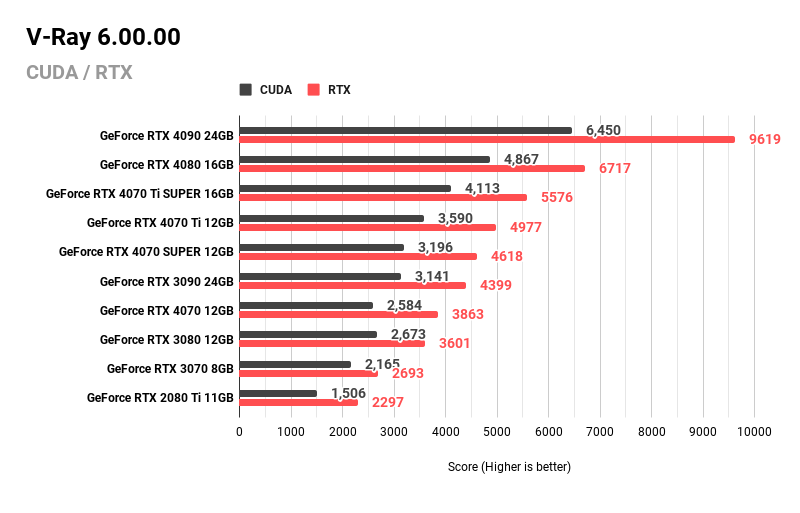
In V-Ray 6’s RTX benchmark run, the RTX 4070 Ti SUPER enjoys a healthy 12% lead over the outgoing RTX 4070 Ti. With this score, it outperforms the RTX 4070 SUPER by 17%.
With a 17% performance uplift and 4GB additional VRAM, you could make the case for a $200 premium for this particular workload. However, once you factor in the possibility of adding more GPUs to your render node, the 2-slot RTX 4070 SUPER at $599 still retains the value crown.
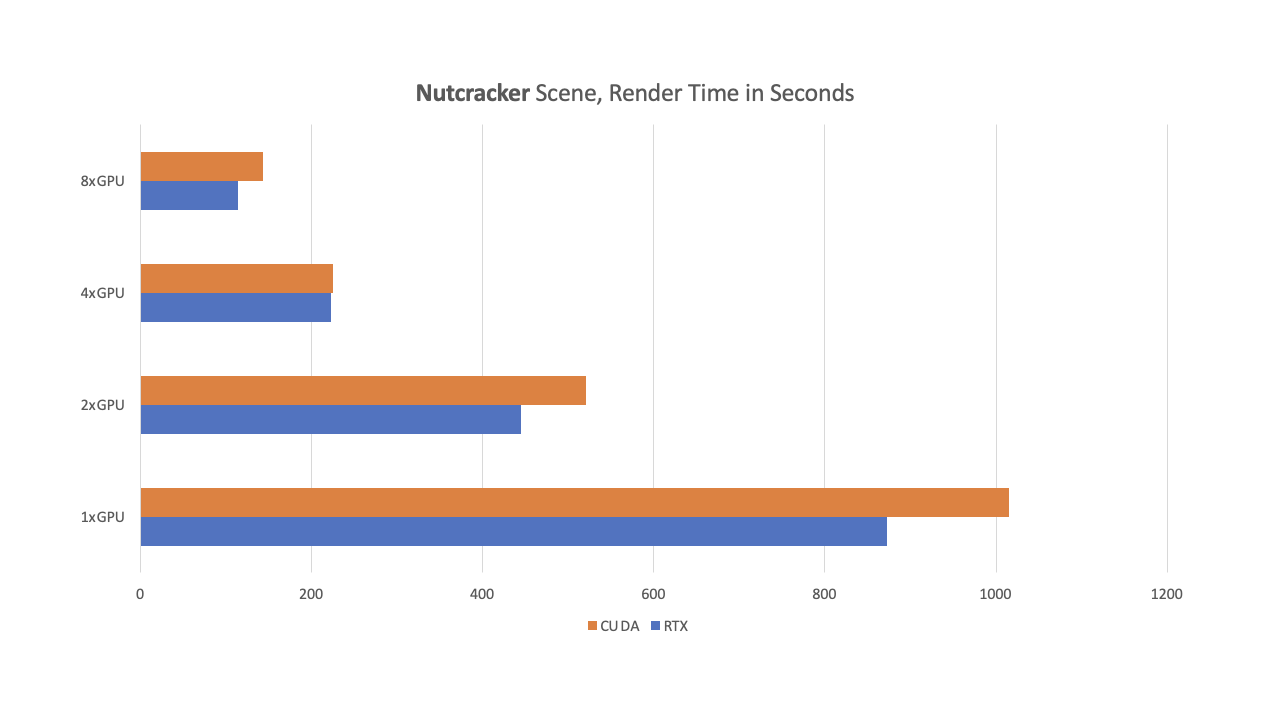
Test using up to 8x 3090 Ti by Chaos
Blender OptiX Render
Blender’s Cycles Renderer in OptiX mode allows NVIDIA graphics cards to obliterate Team Red in any rendering task.
That said, we should have a more exciting contest once we see HIP-RT implementations in the Blender’s stable version (currently experimental). As it stands, Radeon sadly isn’t a good idea for any rendering workload because ray acceleration is an experimental feature, and artists have complained of crashes and ‘artifacting’ when enabling it.
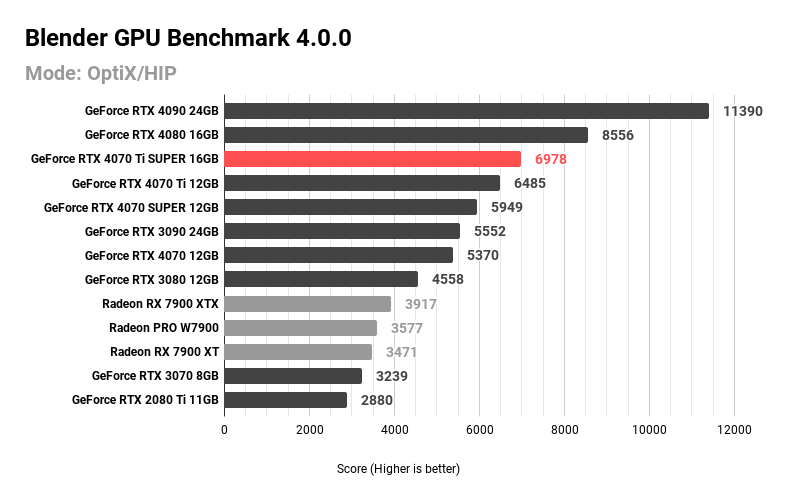
The RTX 4070 Ti SUPER isn’t too interesting here, with only a 7% performance uplift compared to the RTX 4070 Ti. Again, the RTX 4070 SUPER remains the better value option.
Motion Graphics and Animation Benchmarks for RTX 4070 Ti SUPER: Adobe After Effects
Adobe’s Creative Cloud apps have traditionally cared about your GPU only to a certain extent, and it’s always a delicate balance between gaining more performance and spending more money, as the gains can be quite marginal.
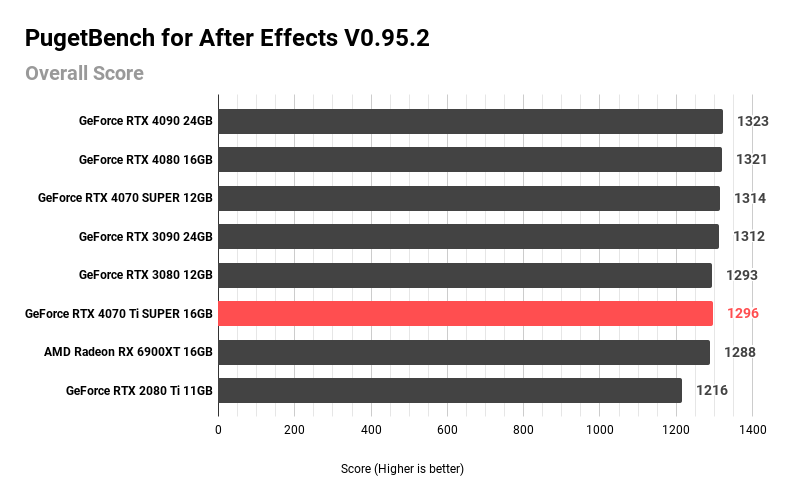
Although we rechecked these results a few times, not only did the RTX 4070 Ti SUPER consistently lose to the RTX 4070 SUPER, but it also couldn’t keep up with the last-gen RTX 3090 and 3080.
The disparity could be caused by the performance bug plaguing this Ventus 3X model from MSI, but I can’t say for sure until we retest later.
Still, even if the performance lined up with the rest of the SKUs, the uplift wouldn’t be more than 2-5% – making it a pretty bad value compared to a card like the RTX 4070 SUPER.
Video Production Benchmarks for the RTX 4070 Ti SUPER: Adobe Premiere Pro and DaVinci Resolve
PugetBench for Premiere Pro
Adobe’s Premiere Pro doesn’t leverage multiple GPUs (like After Effects), so a single powerful card is usually the way to go.
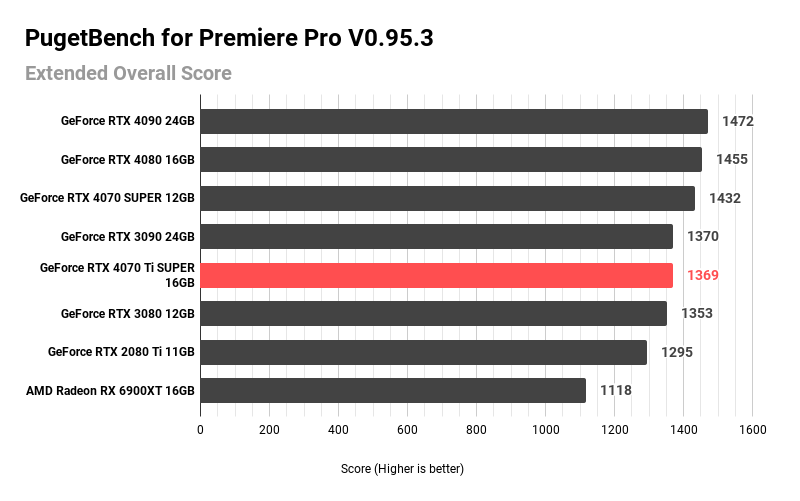
Again, our RTX 4070 Ti SUPER scores much lower than the RTX 4070 SUPER in Premiere Pro. It’s hard to make sense of strange results, but even if the RTX 4070 Ti SUPER lined up between the RTX 4080 and RTX 4070 SUPER, it still wouldn’t be an ideal purchase. The RTX 4070 SUPER remains the best-value GPU for Premiere Pro as well.
PugetBench for DaVinci Resolve
Blackmagic’s DaVinci Resolve has replaced Premiere Pro for many creators as it’s typically better at using the hardware given to it.
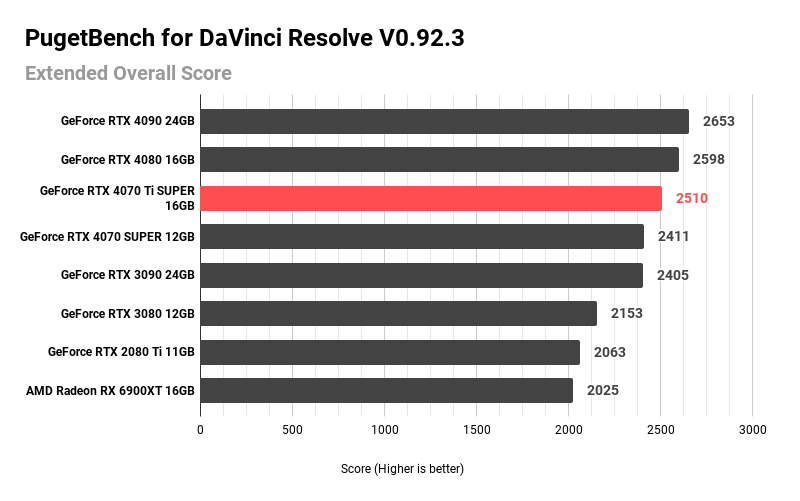
The RTX 4070 Ti SUPER again disappoints, with a dismal 4% uplift to performance in DaVinci Resolve. There’s no contest for video production – the RTX 4070 SUPER should be your pick if you’re looking for the best value.
Stable Diffusion Benchmark for RTX 4070 Ti SUPER: txt2img, 512×512, TensorRT
Generating images using Stable Diffusion benefits from more VRAM, so the RTX 4070 Ti SUPER’s upgraded VRAM buffer should gift it a decent win in at least this particular benchmark.
We’ve started including this test in our benchmark suite because artists are beginning to use these tools for rapid prototyping and quickly getting a template of what they actually want to create.
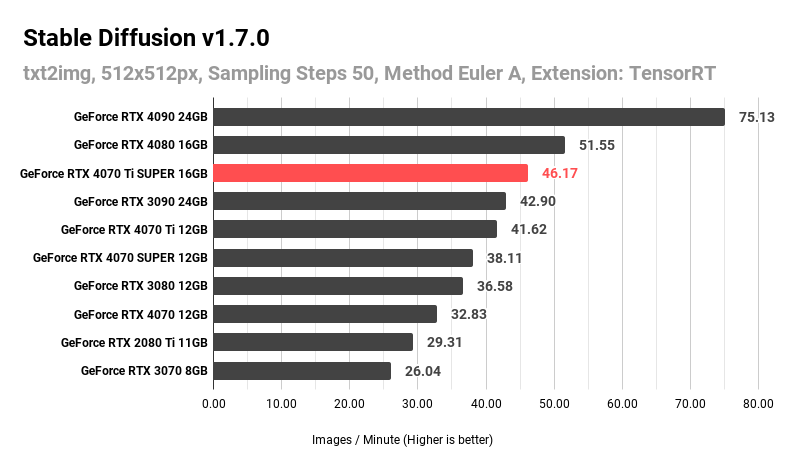
Even with the VRAM bump, the RTX 4070 Ti SUPER only manages to sneak in a 10% lead over the outgoing RTX 4070 Ti. However, this does make it over 21% faster than the RTX 4070 SUPER.
Although I can’t imagine anyone’s primary workload being just AI image generation, the RTX 4070 Ti SUPER is a good pick if that’s the only performance you care about. That said, the upcoming RTX 4080 SUPER will probably offer even better value, so don’t pull the trigger just yet.
RTX 4070 Ti SUPER PCIe Scaling Test: Do PCIe Lanes or Generations Matter?
We’ve gone over the fact that benchmark scenes don’t fully capture the reality of working with large, complex scenes. Before we go over this one, a quick note: if your scenes normally never exceed the VRAM capacity of your graphics card (in this case, 16GB), you can safely ignore this test. However, if your scenes are generally much larger, pay close attention to the motherboard you pick because its PCIe layout will matter.
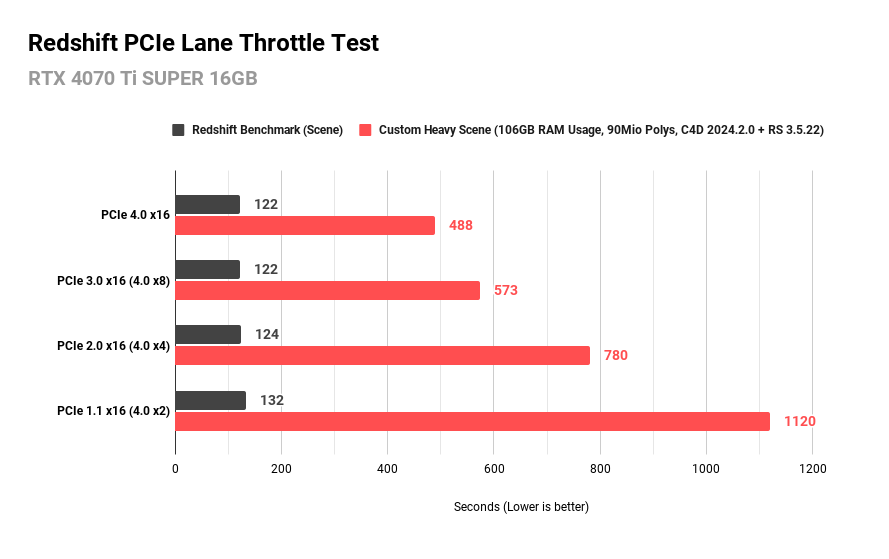
While our RTX 4070 Ti SUPER breezed through the Redshift benchmark scene even when limited to 2 lanes of PCIe 4.0, it had a tough time with our custom, heavy scene. Even with its wider memory interface, dropping to 8 lanes of PCIe 4.0 bandwidth on the RTX 4070 Ti SUPER cut render times by ~17%.
Power Consumption Analysis of the RTX 4070 Ti SUPER: Power Draw, Perf/Watt, and Peak Power Draw
Running renders all day isn’t too uncommon for professionals in the creative space, so excessive power draw begins to sting after a point. Our RTX 4070 Ti SUPER peaked at a whopping 285W when running Furmark.
![RTX 4070 Ti SUPER Maximum Power Draw [Stress, Game, 3D GPU Render]](https://www.cgdirector.com/wp-content/uploads/media/2024/01/RTX-4070-Ti-SUPER-Maximum-Power-Draw-Stress-Game-3D-GPU-Render.png)
However, we don’t build workstations to run Furmark all day, do we? In a range of render engines, we saw a peak power draw of only up to 211W (Octane 2020). As expected, the RTX 4070 Ti SUPER drew more power during our gaming workload of Shadow of the Tombraider at 4K with a peak of 255W.
Power-wise, the RTX 4070 Ti SUPER puts on an outstanding show compared to the rest of the lineup (other than the RTX 4090, which is a different beast altogether).
![Total Board Power Draw [Average] - Octanebench 2020.1.5 (1)](https://www.cgdirector.com/wp-content/uploads/media/2024/01/Total-Board-Power-Draw-Average-Octanebench-2020.1.5-1.png)
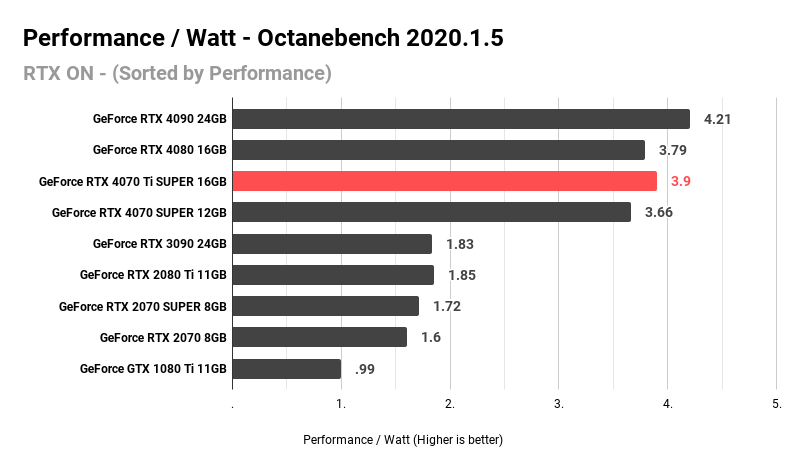
The RTX 4070 Ti SUPER manages to edge out both the RTX 4080 and the RTX 4070 SUPER when it comes to performance per Watt. But does this mean that the RTX 4080 SUPER will surpass or match it? We’ll find out soon! Until then, hold off on your purchase if you’ve decided to go with the RTX 4070 Ti SUPER.
Pricing Analysis of the RTX 4070 Ti SUPER: The Almighty Performance/Dollar
If you want to get the best value for your money, there’s no way you can disregard the performance you get per Dollar you spend. For this chart, we’ll be considering our OctaneBench scores.
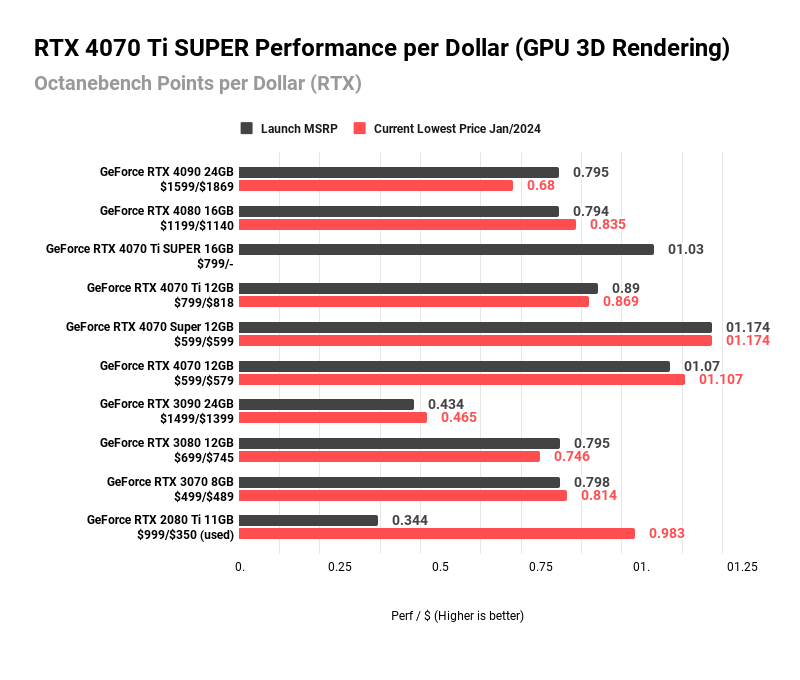
Unfortunately, NVIDIA stays close to its favorite ~1.0 perf/$ ratio with the RTX 4070 Ti SUPER. Notice how bad the 30-series was in this metric?
The RTX 4070 SUPER is the first card to cross that line convincingly in several years, but its elder sibling makes no attempt to do so. My guess? Nvidia decided that the additional VRAM and wider memory interface more than make up for the minor performance bump.
Verdict: Should You buy an RTX 4070 Ti SUPER Graphics Card?
First things first, avoid the MSI VENTUS 3X variant altogether.
Although the performance issues will eventually be fixed, give them a wide berth until a fix is live and confirmed by independent reviewers.
Happy to confirm that the newest vBIOS from MSI fixes the performance issues with its VENTUS 3X model (statement and link to BIOS here)
Now, coming back to the GPU itself. Does the RTX 4070 Ti SUPER offer good value?
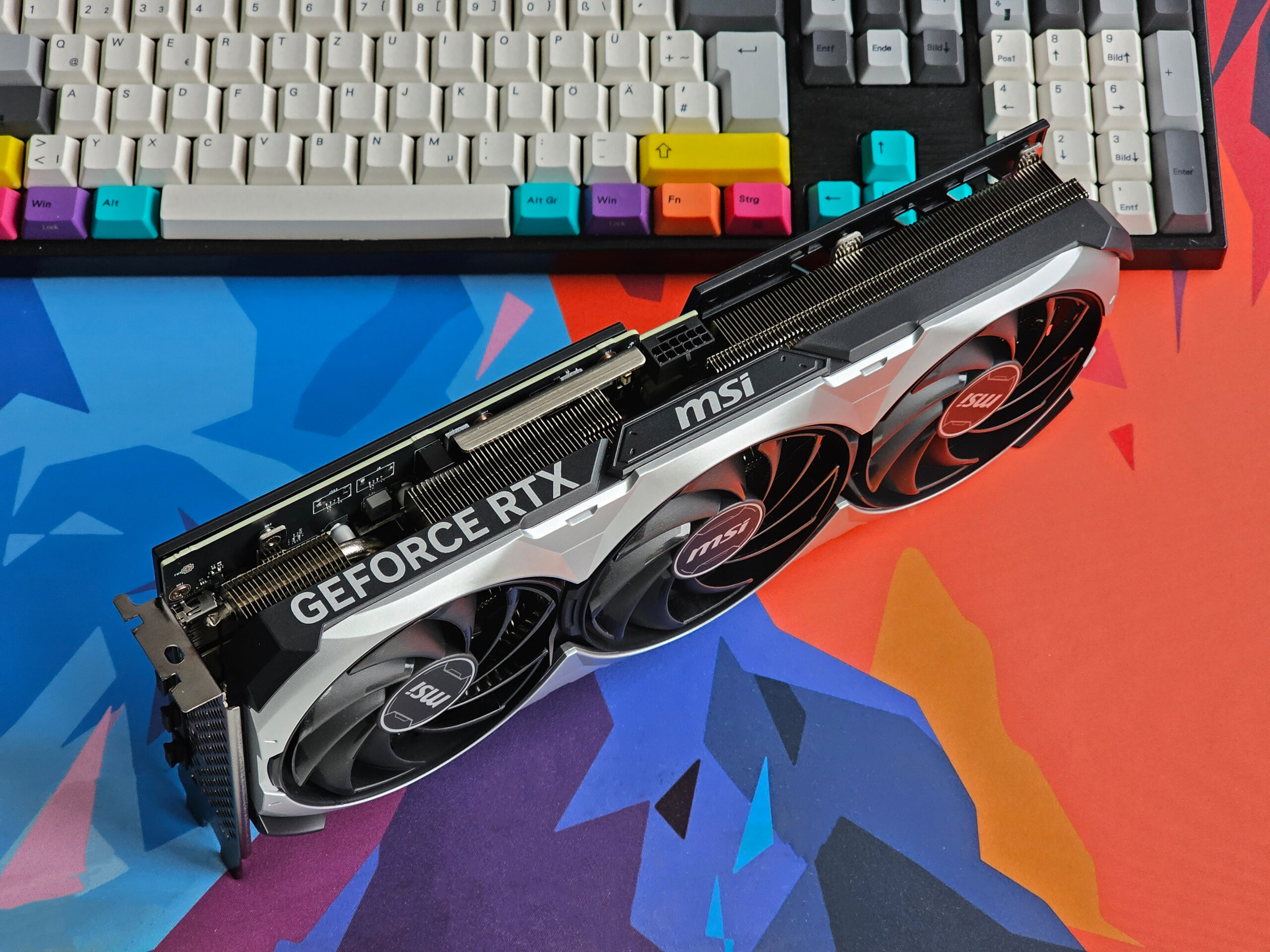
On average, the RTX 4070 Ti SUPER is around 5-12% better than the RTX 4070 Ti.
Technically, it gives you more performance, more VRAM, and a wider memory bus at the same price as the RTX 4070 Ti. But can we call this an ‘improvement,’ when that improvement barely fixes the atrocious price point of the original RTX 4070 Ti (don’t forget: NVIDIA wanted to call it a 4080…).
My guess is that the RTX 4070 Ti SUPER exists for one reason: to upsell you to an RTX 4080 SUPER.
If you were already set on buying an RTX 4070 Ti, well, the RTX 4070 Ti SUPER is straight up better. But since there’s no spectacular value on offer here, you have two options:
- If your workloads are rendering-based and adding more GPUs is a factor, go with an RTX 4070 SUPER and save $200.
- If you need a single powerful card and have up to a $1000 budget, wait for the RTX 4080 SUPER before making the call. It should theoretically offer decent value thanks to a $1000 price point and more performance than an RTX 4080.
Here’s our standard disclaimer that NVIDIA’s RTX 5000 series (or whatever they’ll call it) is slated to launch in around a year. So, if you’re happy with the performance you’re getting right now, you could stick with it for another year. However, if your work demands faster hardware, especially for the workloads we covered above, wait for the RTX 4080 SUPER reviews before pulling out your wallet.
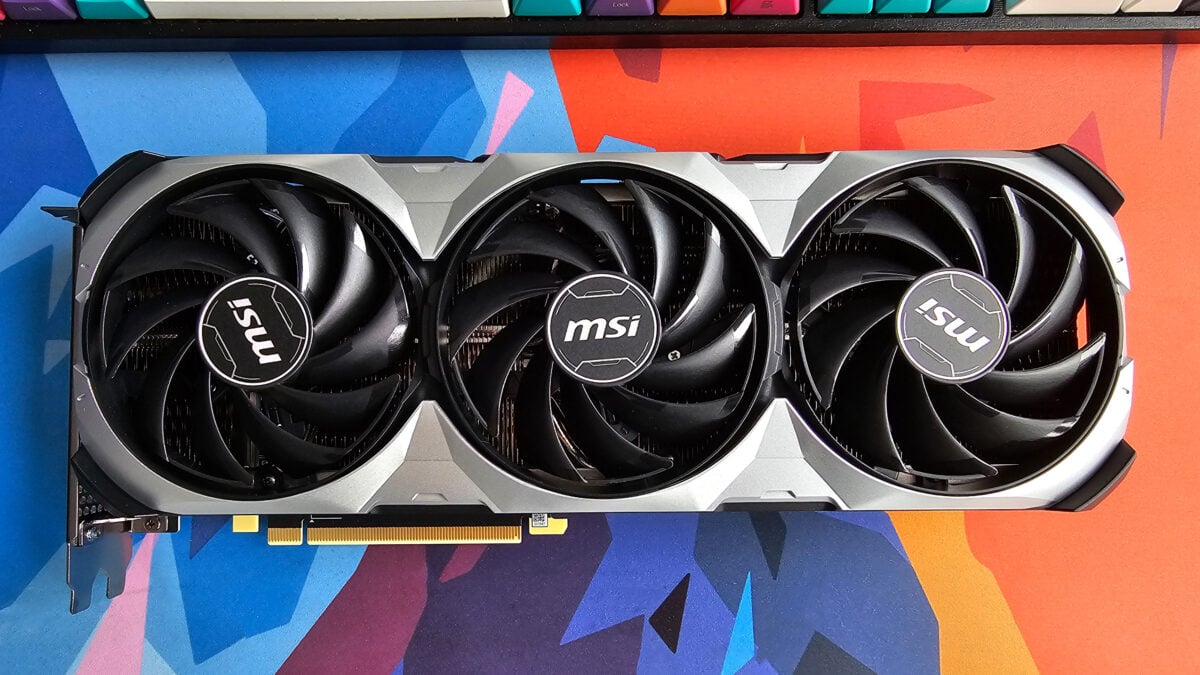
![How Much RAM Does my PC Support? [How to Check] How Much RAM Does my PC Support? [How to Check]](https://www.cgdirector.com/wp-content/uploads/media/2023/10/How-Much-RAM-Can-My-Computer-Take-Twitter-594x335.jpg)


![Guide to Undervolting your GPU [Step by Step] Guide to Undervolting your GPU [Step by Step]](https://www.cgdirector.com/wp-content/uploads/media/2024/04/Guide-to-Undervolting-your-GPU-Twitter-594x335.jpg)

No replies yet
Loading new replies...
Articles & News
Join the full discussion at the CGDirector Forum →